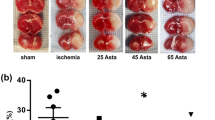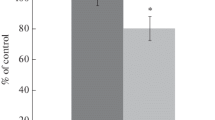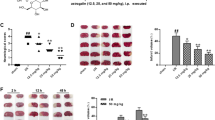Abstract
The aim of present study was to determine the effect of 3′,4′-dihydroxyflavonol (DiOHF) on lipid peroxidation in experimental brain ischemia–reperfusion in rats. Present study was performed on the 34 male Wistar-albino rats, weigth 350-400 g. Experiment groups were designed as 1-Sham; 2-Ischemia–reperfusion; animal were anesthesized and carotid arteried were clemped for 20 min and reperfusion (7 days). 3-DiOHF + Ischemia–reperfusion; DiOHF was given to animals as 10 mg/kg by intraperitoneal. 4- Ischemia + DiOHF + Reperfusion; 5- Ischemia–reperfusion + DiOHF. Blood samples and serebral cortex were analysed for malondyaldehyde (MDA), NO (nitric oxide), xanthine oxidase (XO), glutathione (GSH) and glutathione peroxidase (GPx). Blood MDA levels were significantly higher ischemia–reperfusion groups (P < 0.005). However, DiOHF inhibited MDA. Ischemia–reperfusion led to increased XO and NO but DiOHF supplementation reduced NO and XO. DiOHF increased GSH and GPx levels compared to ischemia–reperfusion group. All together, our present study showed that intraperitoneal DiOHF supplementation has protective effect on brain ischaemia–reperfusion injury in rat.










Similar content being viewed by others

References
Herbert KJ, Hickey MJ, Lepore DA, Knight KR, Morrison WA, Stewart AG (2001) Effects of the endothelin receptor antagonist Bosentan on ischemia/reperfusion injury in rat skeletal muscle. Eur J Pharmacol 424:59–67
Girotti AW (2000) Lipid hydroperoxide generation, turnover, and effector action in biological systems. J Lipid Res 39:1529–1542
Semenza GL (2000) Cellular and molecular dissection of reperfusion injury ROS within and without. Circ Res 86:117–118
Van den Heuvel MGW, Buurman WA, Bast A (2009) Review: ischemia-reperfusion injury in flap surgery. J Plast Reconstr Aesthet Surg 62:721
Harukuni I, Bhardwaj A (2006) Mechanisms of brain injury after global cerebral ischemia. Neurol Clin 24:1–21
Borowicz KK, Piskorska B, Banach M, Czuczwar SJ (2011) Neuroprotective actions of neurosteroids. Front Endocrinol (Lausanne) 2:50
Wojtal K, Trojnar MK, Czuczwar SJ (2006) Endogenous neuroprotective factors: neurosteroids. Pharmacol Rep 58:335–340
Lapi D, Colantuoni A (2015) Remodeling of cerebral microcirculation after ischemia–reperfusion. J Vasc Res 52:22–31
Esposito E, Cordaro M, Cuzzocrea S (2014) Roles of fatty acid ethanolamides (FAE) in traumatic and ischemic brain injury. Pharmacol Res 86:26–31
Ujita S, Mizunuma M, Matsuki N, Ikegaya Y (2011) A synchronously enhanced spiking activity of ischemic neuronal networks. Biol Pharm Bull 34:764–767
Nassar NN, Abdelsalam RM, Abdel-Rahman AA, Abdallah DM (2012) Possible involvement of oxidative stress and inflammatory mediators in the protective effects of the early preconditioning window against transient global ischemia in rats. Neurochem Res 37:614–621
Seif-El-Nasr M, Atia AS, Abdelsalam RM (2008) Effect of MAO-B inhibition against ischemia-induced oxidative stress in the rat brain. Comp Rational Antioxid Arzneim 58:160–167
Hearse DJ, Maxwell L, Saldanha C, Gavin JB (1993) The myocardial vasculature during ischemia and reperfusion: a target for injury and protection. J Mol Cell Cardiol 25:759–800
Sobey CG, Woodman OL (1993) Myocardial ischaemia: what happens to the coronary arteries ? Trends Pharmacol Sci 14:448–453
Aruna Devi R, Lata S, Bhadoria BK, Ramteke VD, Kumar S, Sankar P, Kumar D, Tandan SK (2010) Neuroprotective effect of 5,7,3′,4′,5′-pentahydroxy dihydroflavanol-3-O-(22033-O-galloyl)-beta-D-glucopyranoside, a polyphenolic compound in focal cerebral ischemia in rat. Eur J Pharmacol 626:205–212
Reffelmann T, Kloner RA (2006) The no-reflow phenomenon: a basic mechanism of myocardial ischemia and reperfusion. Basic Res Cardiol 101:359–372
Mogulkoc R, Baltaci AK, Oztekin E, Aydin L, Sivrikaya A (2006) Melatonin prevents oxidant damage in various tissues of rats with hyperthyroidism. Life Sci 79:311–315
Fujii J, Iuchi Y, Okada F (2005) Fundamental roles of reactive oxygen species and protective mechanisms in the female reproductive system. Reprod Biol 3:43
Jennings RB, Reimer KA (1991) The cell biology of acute myocardial ischemia. Annu Rev Med 42:225–246
Kalff JC, Carlos TM, Schraut WH, Billiar TR, Simmons RL, Bauer AJ (1999) Surgically induced leukocytic infiltrates within the rat intestinal muscularis mediate postoperative ileus. Gastroenterology 117:378–387
Cai F, Li C, Wu J, Min Q, Ouyang C, Zheng M, Ma S, Yu W, Lin F (2007) Modulation of the oxidative stress and nuclear factor kappaB activation by theaflavin 3,3′-gallate in the rats exposed to cerebral ischemia-reperfusion. Folia Biol 53:164–172
Mosawy SL, Jackson DE, Woodman OL, Linden MD (2013) Inhibition of platelet-mediated arterial thrombosis and platelet granule exocytosis by 3′,4′-dihydroxyflavonol and quercetin. Platelets 24:594–604
Singh DP, Chopra K (2013) Verapamil augments the neuroprotectant action of berberine in rat model of transient global cerebral ischemia. Eur J Pharmacol 720:98–106
Slate RJ (1986) Experiments in moleculer biology. Humana press, Clifton 269
Ellman GL (1959) Tissue sulfhydryl groups. Arch Biochem Biophys 82:70–77
Chan EC, Drummond GR, Woodman OL (2003) 3′,4′-dihydroxyflavonol enhances nitric oxide bioavailability and improves vascular function after ischemia and reperfusion injury in the rat. J Cardiovasc Pharmacol 42:727–735
Woodman OL, Chan ECH (2004) Vascular and anti-oxidant actions of flavonols and flavones. Clin Exp Pharmacol Physiol 31:786–790
Abd-Elsameea AA, Moustaf AA, Mohamed AM (2014) Modulation of the oxidative stress by metformin in the cerebrum of rats exposed to global cerebral ischemia and ischemia/reperfusion. Eur Rev Med Pharmacol Sci 18:2387–2392
Aras M, Altas M, Meydan S, Nacar E, Karcıoğlu M, Ulutas KT, Serarslan Y (2014) Effects of ebselen on ischemia/reperfusion injury in rat brain. Int J Neurosci 124:771–776
Shao A, Guo S, Tu S, Ammar AB, Tang J, Hong Y, Wu H, Zhang J (2014) Astragaloside IV alleviates early brain injury following experimental subarachnoid hemorrhage in rats. Int J Med Sci 11:1073–1081
Ono T, Tsuruta R, Fujita M, Aki HS, Kutsuna S, Kawamura Y, Wakatsuki J, Aoki T, Kobayashi C, Kasaoka S, Maruyama I, Yuasa M, Maekawa T (2009) Xanthine oxidase is one of the major sources of superoxide anion radicals in blood after reperfusion in rats with forebrain ischemia/reperfusion. Brain Res 1:158–167
Yaidikar L, Byna B, Thakur SR (2014) Neuroprotective effect of punicalagin against cerebral ischemia reperfusion-induced oxidative brain injury in rats. J Stroke Cerebrovasc Dis 23:2869–2878
Ghoneim AI, Abdel-Naim AB, Khalifa AE, El-Denshary ES (2002) Protective effects of curcumin against ischaemia/reperfusion insult in rat forebrain. Pharmacol Res 46:273–279
Ghosh A, Sarkar S, Mandal AK, Das N (2013) Neuroprotective role of nanoencapsulated quercetin in combating ischemia-reperfusion induced neuronal damage in young and aged rats. PLoS One 19:e57735
Ilhan A, Yilmaz HR, Armutcu F, Gurel A, Akyol O (2004) The protective effect of nebivolol on ischemia/reperfusion injury in rabbit spinal cord. Prog Neuropsychopharmacol Biol Psychiatry 28:1153–1160
Chen G, Yang J, Lu G, Guo J, Dou Y (2014) Limb remote ischemic post-conditioning reduces brain reperfusion injury by reversing eNOS uncoupling. Indian J Exp Biol 52:597–605
Agouni A, Lagrue-Lak-Hal AH, Mostefai HA, Tesse A, Mulder P, Rouet P, Desmoulin F, Heymes C, Martínez MC, Andriantsitohaina R (2009) Red wine polyphenols prevent metabolic and cardiovascular alterations associated with obesity in Zucker fatty rats (Fa/Fa). PLoS One 4:e5557
Wang CZ, Mehendale SR, Calway T, Yuan CS (2011) Botanical flavonoids on coronary heart disease. Am J Chin Med 39:661–671
Wang KW, Wang HK, Chen HJ, Liliang PC, Liang CL, Tsai YD, Cho CL, Lu K (2014) Simvastatin combined with antioxidant attenuates the cerebral vascular endothelial inflammatory response in a rat traumatic brain injury. Biomed Res Int 2014:910260
Xu M, Chen X, Gu Y, Peng T, Yang D, Chang RC, So KF, Liu K, Shen J (2013) Baicalin can scavenge peroxynitrite and ameliorate endogenous peroxynitrite-mediated neurotoxicity in cerebral ischemia-reperfusion injury. J Ethnopharmacol 150:116–124
Guo Y, Chen ZW (2008) Protective effects of total flavones of rhododendra on cerebral ischemia reperfusion injury. Am J Chin Med 36:343–354
Ross D (1988) Glutathione, free radicals and chemotherapeutic agents. Pharmacol Ther 37:231–249
Al-Majed AAL, Al-Omar FA, Nagi MN (2006) Neuroprotective effects of thymoquinone against transient forebrain ischemia in the rat hippocampus. Eur J Pharmacol 543:40–47
Al-Omar FA, Nagi MN, Abdulgadir MM, Al Joni KS, Al-Majed AA (2006) Immediate and delayed treatments with curcumin prevents forebrain ischemia-induced neuronal damage and oxidative insult in the rat hippocampus. Neurochem Res 31:611–618
Mukherjee PK, Ahamed KF, Kumar V, Mukherjee K, Houghton PJ (2007) Protective effect of biflavones from Araucaria bidwillii Hook in rat cerebral ischemia/reperfusion induced oxidative stress. Behav Brain Res 178:221–228
Cosar M, Kaner T, Sahin O, Topaloglu N, Guven M, Aras AB, Akman T, Ozkan A, Sen HM, Memi G, Deniz M (2014) The neuroprotective effect of Sulindac after ischemia-reperfusion injury in rats. Acta Cir Bras 29:268–273
Selvaraj P, Pugalendi KV (2010) Hesperidin, a flavanone glycoside, on lipid peroxidation and antioxidant status in experimental myocardial ischemic rats. Redox Rep 15:217–223
Sizlan A, Guven A, Uysal B, Yanarates O, Atim A, Oztas E, Cosar A, Korkmaz A (2009) Proanthocyanidin protects intestine and remote organs against mesenteric ischemia/reperfusion injury. World J Surg 33:1384–1391
Sun YX, Tang Y, Wu AL, Liu T, Dai XL, Zheng QS, Wang ZB (2010) Neuroprotective effect of liquiritin against focal cerebral ischemia/reperfusion in mice via its antioxidant and antiapoptosis properties. J Asian Nat Prod Res 12:1051–1060
Xu JX, Yang M, Deng KJ, Zhou H (2011) Antioxidant activities of Dracocephalum tanguticum maxim extract and its up-regulation on the expression of neurotrophic factors in a rat model of permanent focal cerebral ischemia. Am J Chin Med 39:65–81
Muley MM, Thakare VN, Patil RR, Kshirsagar AD, Naik SR (2012) Silymarin improves the behavioural, biochemical and histoarchitecture alterations in focal ischemic rats: a comparative evaluation with piracetam and protocatachuic acid. Pharmacol Biochem Behav 102:286–293
Shi GF, Wang GY, Chen XF (2013) Screening of radical-scavenging natural neuroprotective antioxidants from Swertia chirayita. Acta Biol Hung 64:267–278
Cao D, Li H, Yi J, Zhang J, Che H, Cao J, Yang L, Zhu C, Jiang W (2011) Antioxidant properties of the mung bean flavonoids on alleviating heat stress. PLoS One 6:21071
Hatipoglu A, Kanbagli O, Balkan J, Kucuk M, Cevikbas U, Aykaç-Toker G, Berkkan H, Uysal M (2004) Hazelnut oil administration reduces aortic cholesterol accumulation and lipid peroxides in the plasma, liver, and aorta of rabbits fed a high-cholesterol diet. Biosci Biotechnol Biochem 68:2050–2057
Acknowledgments
This study was supported by a grant Selcuk University, Scientific Research Council (Grant Number is 14202015).
Author information
Authors and Affiliations
Corresponding author
Ethics declarations
Conflict of interest
All the authors do not have any possible conflicts of interest.
Rights and permissions
About this article
Cite this article
Caliskan, M., Mogulkoc, R., Baltaci, A.K. et al. The Effect of 3′,4′-Dihydroxyflavonol on Lipid Peroxidation in Rats with Cerebral Ischemia Reperfusion Injury. Neurochem Res 41, 1732–1740 (2016). https://doi.org/10.1007/s11064-016-1889-x
Received:
Revised:
Accepted:
Published:
Issue Date:
DOI: https://doi.org/10.1007/s11064-016-1889-x



